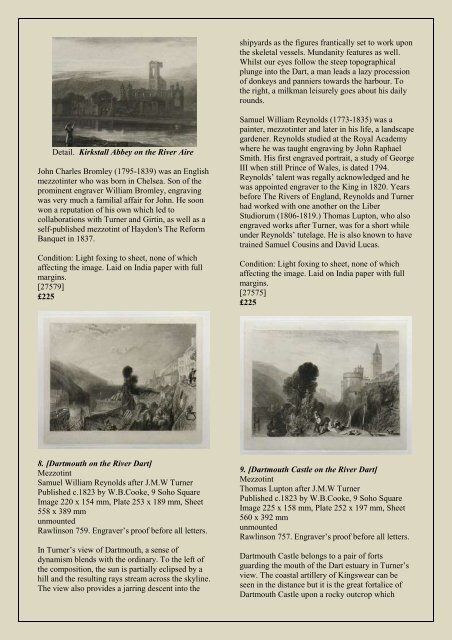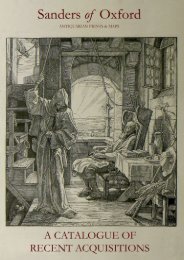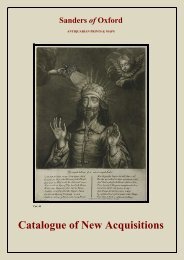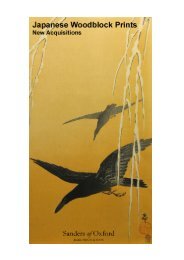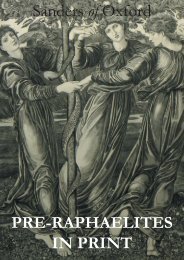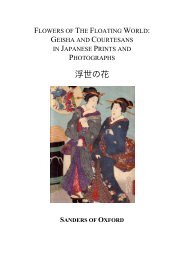Mezzotints & Engravings after J.M.W.Turner.pdf - Sanders of Oxford
Mezzotints & Engravings after J.M.W.Turner.pdf - Sanders of Oxford
Mezzotints & Engravings after J.M.W.Turner.pdf - Sanders of Oxford
You also want an ePaper? Increase the reach of your titles
YUMPU automatically turns print PDFs into web optimized ePapers that Google loves.
Detail. Kirkstall Abbey on the River Aire<br />
John Charles Bromley (1795-1839) was an English<br />
mezzotinter who was born in Chelsea. Son <strong>of</strong> the<br />
prominent engraver William Bromley, engraving<br />
was very much a familial affair for John. He soon<br />
won a reputation <strong>of</strong> his own which led to<br />
collaborations with <strong>Turner</strong> and Girtin, as well as a<br />
self-published mezzotint <strong>of</strong> Haydon's The Reform<br />
Banquet in 1837.<br />
Condition: Light foxing to sheet, none <strong>of</strong> which<br />
affecting the image. Laid on India paper with full<br />
margins.<br />
[27579]<br />
£225<br />
8. [Dartmouth on the River Dart]<br />
Mezzotint<br />
Samuel William Reynolds <strong>after</strong> J.M.W <strong>Turner</strong><br />
Published c.1823 by W.B.Cooke, 9 Soho Square<br />
Image 220 x 154 mm, Plate 253 x 189 mm, Sheet<br />
558 x 389 mm<br />
unmounted<br />
Rawlinson 759. Engraver’s pro<strong>of</strong> before all letters.<br />
In <strong>Turner</strong>’s view <strong>of</strong> Dartmouth, a sense <strong>of</strong><br />
dynamism blends with the ordinary. To the left <strong>of</strong><br />
the composition, the sun is partially eclipsed by a<br />
hill and the resulting rays stream across the skyline.<br />
The view also provides a jarring descent into the<br />
shipyards as the figures frantically set to work upon<br />
the skeletal vessels. Mundanity features as well.<br />
Whilst our eyes follow the steep topographical<br />
plunge into the Dart, a man leads a lazy procession<br />
<strong>of</strong> donkeys and panniers towards the harbour. To<br />
the right, a milkman leisurely goes about his daily<br />
rounds.<br />
Samuel William Reynolds (1773-1835) was a<br />
painter, mezzotinter and later in his life, a landscape<br />
gardener. Reynolds studied at the Royal Academy<br />
where he was taught engraving by John Raphael<br />
Smith. His first engraved portrait, a study <strong>of</strong> George<br />
III when still Prince <strong>of</strong> Wales, is dated 1794.<br />
Reynolds’ talent was regally acknowledged and he<br />
was appointed engraver to the King in 1820. Years<br />
before The Rivers <strong>of</strong> England, Reynolds and <strong>Turner</strong><br />
had worked with one another on the Liber<br />
Studiorum (1806-1819.) Thomas Lupton, who also<br />
engraved works <strong>after</strong> <strong>Turner</strong>, was for a short while<br />
under Reynolds’ tutelage. He is also known to have<br />
trained Samuel Cousins and David Lucas.<br />
Condition: Light foxing to sheet, none <strong>of</strong> which<br />
affecting the image. Laid on India paper with full<br />
margins.<br />
[27575]<br />
£225<br />
9. [Dartmouth Castle on the River Dart]<br />
Mezzotint<br />
Thomas Lupton <strong>after</strong> J.M.W <strong>Turner</strong><br />
Published c.1823 by W.B.Cooke, 9 Soho Square<br />
Image 225 x 158 mm, Plate 252 x 197 mm, Sheet<br />
560 x 392 mm<br />
unmounted<br />
Rawlinson 757. Engraver’s pro<strong>of</strong> before all letters.<br />
Dartmouth Castle belongs to a pair <strong>of</strong> forts<br />
guarding the mouth <strong>of</strong> the Dart estuary in <strong>Turner</strong>’s<br />
view. The coastal artillery <strong>of</strong> Kingswear can be<br />
seen in the distance but it is the great fortalice <strong>of</strong><br />
Dartmouth Castle upon a rocky outcrop which


